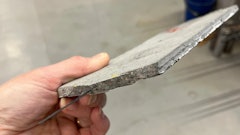For several years life-cycle cost analysis has become one of the most important tools available to transportation agency officials for making informed paving material choices that best serve the public interest. Recommended by the Federal Highway Administration, this process has allowed several states to save taxpayers millions of dollars, improve roadway performance and make decision-making a far more transparent process.
Groundbreaking research taking place at the Massachusetts Institute of Technology (MIT) is providing the use of life-cycle cost analysis (LCCA) a dramatic shot in the arm. Researchers at MIT’s Concrete Sustainability Hub have recently released the construction industry’s first comprehensive and credible research study that measures the impact of inflation on the choice of paving materials over the life cycle of a road construction project.
The key finding in the research is that, largely because of the high price volatility of asphalt, traditional methods of conducting life-cycle cost analysis are flawed because they do not provide for any differences in the long-term costs of each building material. Based on current practice, the research shows, that assuming the cost increases of asphalt and concrete will remain constant is “seriously inconsistent with historical experience.” What’s more, the study shows that “ignoring that experience can lead to serious cost overruns.”
In conducting the simulations over a 50-year period, the researchers found that the mean real price of concrete decreases by 20 percent. Over the same period, the mean price of asphalt increases by a whopping 95 percent. “More specifically,” the researchers note, “overall inflation outstripped concrete inflation, while it is the opposite case for asphalt.” In other words, the cost of concrete would be below overall inflation rates in most cases, while the cost of asphalt would be above overall inflation rates in most cases.
To reach those conclusions, the researchers performed a thousand simulations using a 10-mile, four-lane highway project as a representative sample. The simulations assumed that the highway could be built with either asphalt or concrete. The researchers noted that although the highway would have similar functionality either way, the cost profiles would be different based on the different characteristics of the material. Concrete pavement is more durable and more of the lifetime costs of the road would be in the initial construction. Asphalt requires more frequent maintenance, so a large portion of its costs would be spread throughout the life of the project.
“At a time when transportation officials are under more pressure than ever to make the most cost-effective decisions and to communicate the reasons for those decisions to the public, this research creates a new model for decision-making that saves taxpayer money over the long-term life of a road,” Brian McCarthy, president and CEO of the Portland Cement Association (PCA) said.
To even further simplify the process of accounting for inflation in life-cycle cost analysis, the MIT team has developed an Excel-based program with an associated data file that allows a decision-maker to verify/upgrade this work as well as to evaluate alternative construction projects. The software package is available at http://www.palisade.com/risk/. Risk is a Microsoft Excel add-on and the Excel/risk data file associated with the research allows one to perform the verifications and upgrades required for the analysis. The complete research is available at the MIT Concrete Sustainability Hub Web site at http://web.mit.edu/cshub/news/pdf/Inflation%20and%20Volatility.pdf


























